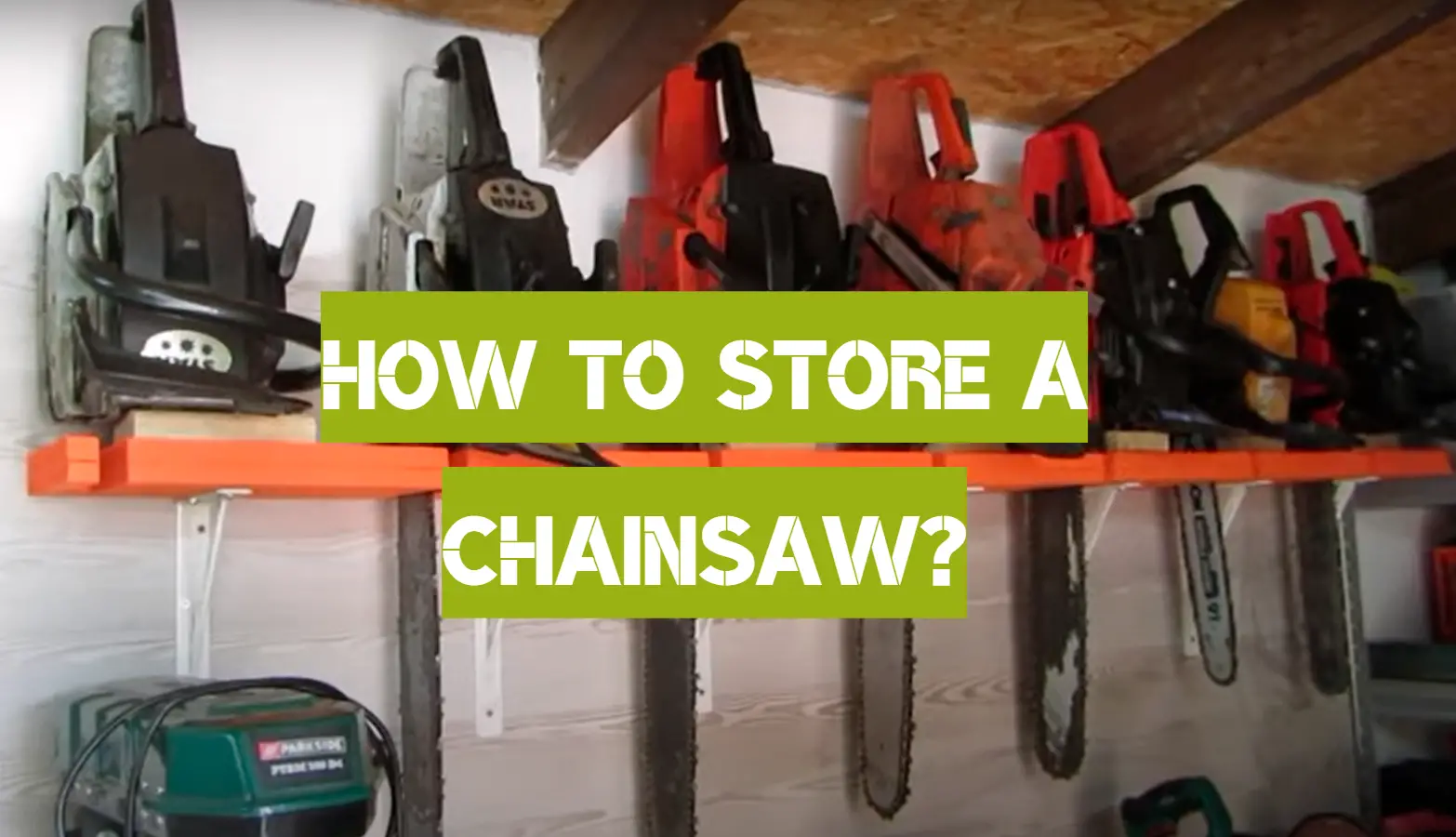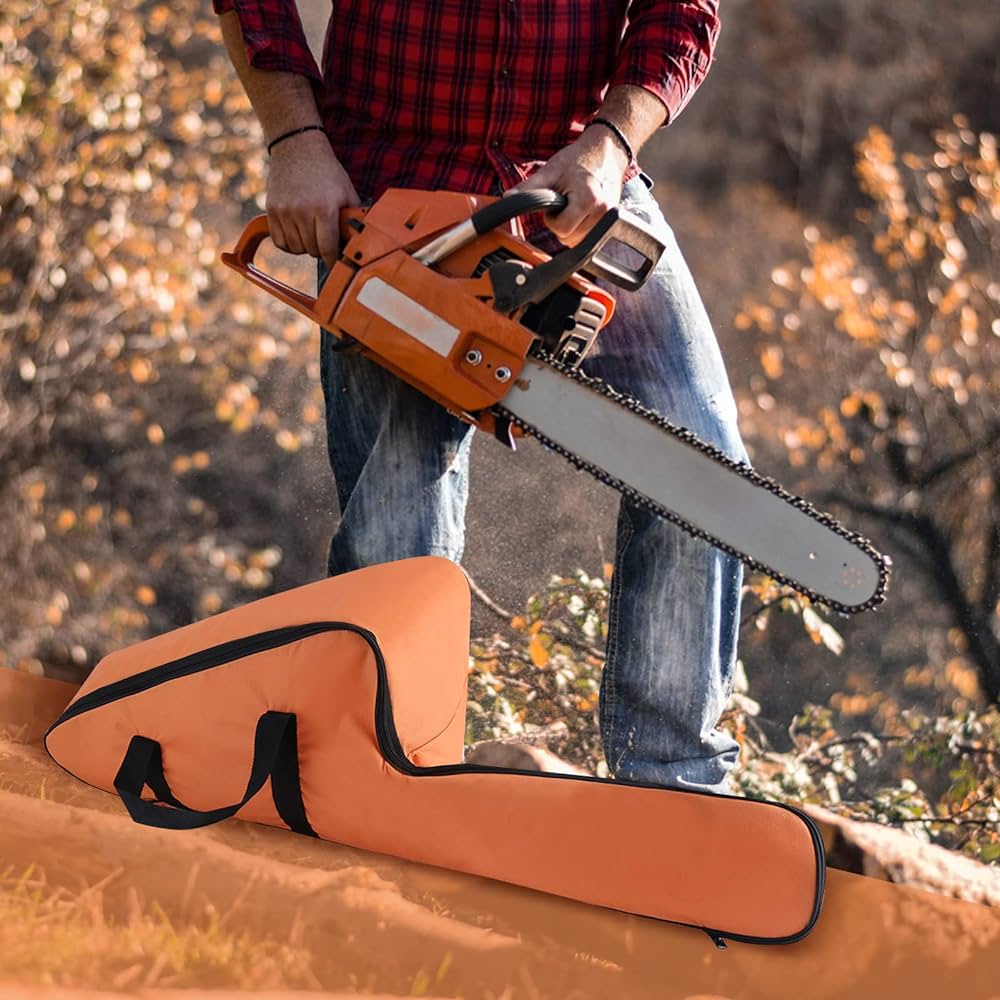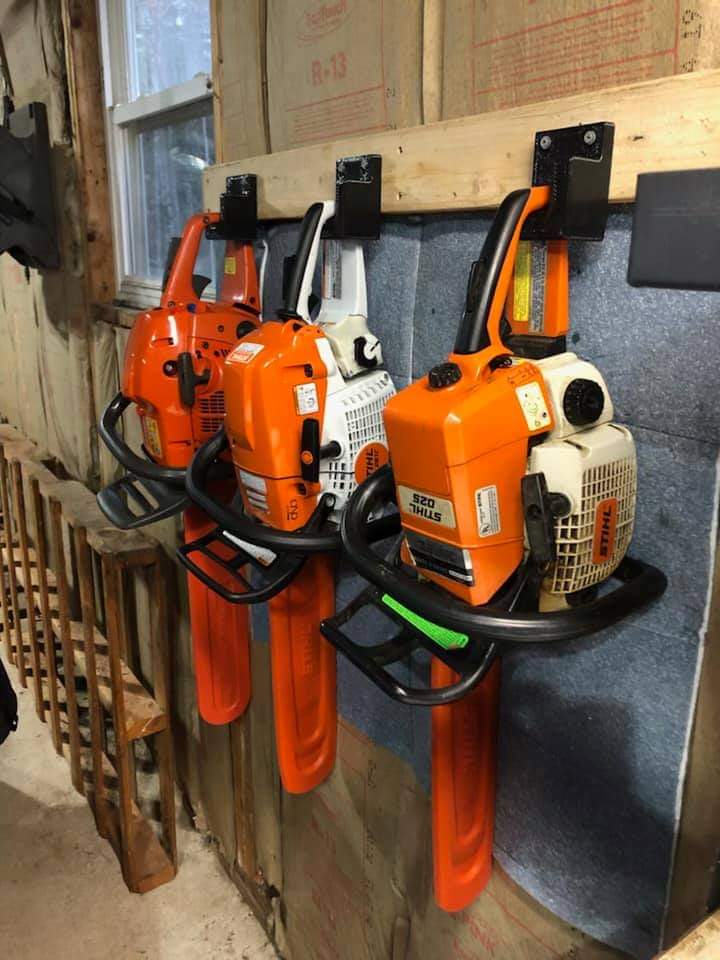Chainsaw Storage Ideas
Chainsaws, powerful tools that they are, have become indispensable assets in various outdoor tasks, from tree cutting and firewood preparation to landscaping and construction projects. However, like any tool, they demand respect and responsible handling, not only during operation but also during storage. The importance of proper chainsaw storage cannot be overstated, as it ensures the longevity of your equipment, protects those around you, and prevents potential hazards that can arise from improper storage practices.
Improper storage of chainsaws can lead to a host of problems. Firstly, it poses a significant safety risk. An inadequately stored chainsaw can result in accidental starts, exposing users and others to serious injuries. Furthermore, incorrect storage can lead to a decline in the chainsaw’s performance and lifespan, requiring costly repairs or replacements. Beyond safety and maintenance concerns, improper storage can also make your equipment susceptible to theft and environmental damage.
In this article, we will delve into the art of chainsaw storage, providing you with a range of creative and effective solutions to keep your chainsaw safe, accessible, and well-maintained. Whether you’re a professional logger, a seasoned homeowner tackling occasional yard work, or a novice just starting your chainsaw journey, our goal is to empower you with the knowledge and ideas needed to ensure your chainsaw remains a reliable and valuable asset, all while mitigating the potential dangers of improper storage. So, let’s explore the world of smart chainsaw storage solutions that will not only safeguard your equipment but also offer peace of mind for you and your loved ones.
Indoor Chainsaw Storage
Indoor storage for your chainsaw offers numerous benefits, primarily centered around safeguarding your valuable equipment and ensuring it’s readily accessible when you need it. Here, we’ll delve into the advantages of indoor chainsaw storage and explore some practical ideas for achieving this.
Benefits of Indoor Chainsaw Storage:
- Protection from the Elements: Storing your chainsaw indoors shields it from the harsh outdoor elements. This is crucial for preventing rust, corrosion, and damage caused by exposure to rain, snow, or extreme temperatures.
- Security: Indoor storage provides an added layer of security, reducing the risk of theft or unauthorized use. It also keeps your chainsaw out of sight from potential thieves.
- Extended Lifespan: Proper indoor storage helps extend the lifespan of your chainsaw. It prevents the degradation of crucial components, such as the chain, engine, and housing, which can occur when exposed to moisture and UV radiation.
- Ease of Access: When you need your chainsaw for a project, having it stored indoors means you can access it quickly and without the hassle of moving it from an outdoor location. This efficiency is particularly valuable in emergency situations or when tackling time-sensitive tasks.
Ideas for Indoor Chainsaw Storage
- Wall Mounts: Wall mounts are a space-saving solution that keeps your chainsaw off the ground and easily accessible. You can install wall mounts in your garage, workshop, or toolshed. Consider mounting a sturdy bracket or hook to the wall, specifically designed for chainsaw storage. Make sure the chainsaw is securely hung, with the chain and bar facing upwards. This helps prevent accidental contact with the sharp cutting components.
- Cabinets: A dedicated cabinet is an excellent choice for indoor chainsaw storage. Opt for a cabinet with lockable doors to enhance security. Inside the cabinet, you can place your chainsaw on a shelf or hang it using hooks or brackets. Cabinets also provide extra space for organizing chainsaw accessories, such as spare chains, oils, and safety equipment.
- Designated Shelves: Custom-built or purpose-designed shelves are ideal for those with a collection of tools, including chainsaws. Shelves can be installed at a convenient height and can accommodate multiple chainsaws, along with their accessories. It’s important to ensure that the chainsaws are securely fastened to prevent accidents.
Tips on Organizing Chainsaw Accessories
Properly organizing chainsaw accessories is crucial for efficiency and safety. Here are some tips:
- Labeling: Use clear labels or storage bins to categorize and identify your chainsaw accessories. This makes it easier to locate items quickly.
- Safety Gear: Store your safety equipment, such as goggles, gloves, and ear protection, in close proximity to your chainsaw storage area. This encourages the use of safety gear every time you use the chainsaw.
- Spare Parts and Maintenance Tools: Dedicate a section of your indoor storage area for spare chains, bar oil, spark plugs, and maintenance tools. Ensure everything is well-organized, and regularly check the condition of your spare parts.
- Maintenance Schedule: Keep a visible record or calendar in your storage area to track the maintenance schedule for your chainsaw. This will help ensure your equipment remains in good working order.
Indoor chainsaw storage offers superior protection, security, and convenience. Utilizing wall mounts, cabinets, or designated shelves can keep your chainsaw in top condition and ready for use, while organizing accessories properly ensures safety and efficiency during operation.
Outdoor Chainsaw Storage
Chainsaws are versatile tools, often employed for outdoor tasks such as tree cutting, firewood preparation, and yard maintenance. Given their rugged nature and the potential mess associated with their use, it’s often more practical to store them outdoors, especially when dealing with larger equipment. Outdoor chainsaw storage serves several purposes, addressing the need for both convenience and protection.
The Need for Outdoor Storage:
- Space Requirements: Large chainsaws, such as professional-grade models, can be bulky and cumbersome to store indoors. They may take up valuable space that could be utilized for other purposes, such as a workshop or garage. By moving these tools outdoors, you can free up indoor space.
- Minimizing Mess: Chainsaws tend to accumulate dirt, sawdust, and oil, which can create a messy environment if stored inside. Keeping them outdoors can help contain the mess and prevent your indoor areas from becoming cluttered or soiled.
- Ventilation: Storing chainsaws outdoors also allows for better ventilation. The fumes and odors associated with chainsaw fuel and lubricants can be harmful when trapped indoors. Outdoor storage reduces the risk of exposure to these potentially hazardous substances.
Storage Options for Outdoor Chainsaw Storage:
- Weatherproof Sheds: Weatherproof sheds, also known as tool sheds, are excellent choices for outdoor chainsaw storage. These sheds come in various sizes and designs, providing ample space not only for your chainsaw but also for other tools and equipment. Look for models with reinforced floors, windows for natural light, and durable locks to keep your chainsaw secure.
- Lockable Containers: Lockable containers, like deck boxes or heavy-duty storage bins, can be a cost-effective solution for keeping your chainsaw safe and dry. Ensure the container is weather-resistant and large enough to accommodate the chainsaw comfortably. You can secure these containers with padlocks or combination locks for added security.
- Dedicated Chainsaw Racks: For those who want a more specialized approach, dedicated chainsaw racks are designed to securely hold your chainsaw. These racks are typically made of durable materials like metal or plastic and come with slots or hooks to accommodate the tool. They are often wall-mounted or stand-alone structures, offering easy access while keeping your chainsaw protected.
Security Measures to Prevent Theft:
Chainsaws can be valuable tools, and their portability makes them susceptible to theft if not properly secured in outdoor storage. Here are some security measures to consider:
- Locks and Cables: Equip your outdoor storage option with a high-quality lock and use steel cables or chains to secure the chainsaw within the storage area. This deters opportunistic thieves.
- Security Cameras: Install outdoor security cameras near your storage area to monitor any suspicious activity. Visible cameras can act as a deterrent and provide evidence in case of theft.
- Motion-Activated Lights: Install motion-activated lights around your outdoor storage area. Bright lights can startle potential thieves and make them more visible, reducing the likelihood of a successful theft.
- Property Fencing: Consider adding fencing or barriers around your outdoor storage area to limit access. Tall and sturdy fences can serve as an extra layer of protection.
- Property Marking: Engrave or mark your chainsaw with a unique identification number. This makes it easier to identify and recover your equipment if it’s stolen.
By implementing outdoor chainsaw storage solutions and taking appropriate security measures, you can keep your chainsaw safe, well-protected, and ready for action whenever you need it, while also ensuring that it doesn’t take up valuable space inside your home or workshop.
Portable Chainsaw Cases and Bags
When it comes to chainsaw storage and transportation, portable chainsaw cases and bags offer a convenient and versatile solution. Whether you need to transport your chainsaw to a job site or simply want a protective covering for storage in your workshop, these options are designed to keep your equipment safe and accessible.
Convenience of Portable Storage
Portable chainsaw cases and bags are favored by both professional woodworkers and hobbyists alike for their convenience. Here’s why they are a smart choice:
- Mobility: These cases and bags are typically designed with handles or shoulder straps, making it easy to carry your chainsaw wherever you need it. Whether you’re heading to a distant worksite or just moving it around your property, the portability of these options is a significant advantage.
- Protection: Portable cases and bags are built with the primary goal of protecting your chainsaw from damage. They shield your equipment from dust, moisture, and impacts, ensuring that it remains in excellent working condition.
- Organization: Many of these cases and bags come with compartments and pockets for storing chains, bar oil, tools, and other accessories. This helps you keep everything you need in one place, reducing the risk of losing or misplacing important items.
Chainsaw Cases
Chainsaw cases are rigid, durable containers designed specifically to accommodate chainsaws. They offer a high level of protection during transportation and storage. Here are some considerations when choosing a chainsaw case:
- Size: Ensure that the case is the right size for your chainsaw. Most cases are designed to fit specific chainsaw models, so check the manufacturer’s recommendations. Measure your chainsaw’s dimensions, including the bar length, to find a suitable case.
- Material: Chainsaw cases are typically made from sturdy materials like high-density plastic or metal. Look for a case with good build quality to ensure it can withstand the rigors of transportation.
- Lockability: Some chainsaw cases come with locking mechanisms to enhance security during storage or when transporting your chainsaw. This can be especially important if you want to prevent unauthorized access.
Chainsaw Bags
Chainsaw bags, on the other hand, are more flexible and lighter than cases. They are typically made from heavy-duty fabric or nylon. Here’s what to consider when selecting a chainsaw bag:
- Compatibility: Check that the bag is designed to fit your chainsaw’s bar length and size. Most bags are adjustable to accommodate different models, but it’s essential to confirm this before purchasing.
- Durability: Look for a bag made from robust and water-resistant materials. It should be able to withstand outdoor conditions and protect your chainsaw from moisture and debris.
- Comfort and Convenience: Chainsaw bags often come with padded straps or handles for comfortable carrying. Ensure that the bag’s design suits your preferences and needs.
Choosing the Right Case or Bag
To choose the right chainsaw case or bag for your needs, consider the following factors:
- Chainsaw Model: Ensure that the case or bag is compatible with your specific chainsaw model, including its size and bar length.
- Durability: Assess the material and build quality to make sure it can provide the level of protection you require.
- Transportation Needs: Think about how you’ll be using the case or bag. If you need to carry it long distances, a case with a comfortable handle or strap might be more suitable. If you just need basic storage and short-distance transportation, a bag could suffice.
- Additional Storage: If you want to store chainsaw accessories along with your equipment, look for a case or bag with extra compartments or pockets.
- Budget: Consider your budget, but also remember that investing in a quality chainsaw case or bag is a smart way to protect your valuable equipment.
Portable chainsaw cases and bags offer the flexibility, protection, and convenience that chainsaw owners need. By choosing the right case or bag based on your equipment, transportation requirements, and preferences, you can ensure that your chainsaw remains safe and in optimal condition, whether you’re on the go or in your workshop.
Chainsaw Wall Hangers and Hooks
When it comes to efficient and space-saving chainsaw storage, wall hangers and hooks are an excellent solution. These storage options not only keep your chainsaw easily accessible but also free up valuable floor or shelf space in your workshop or garage. In this section, we’ll delve into the benefits of using chainsaw wall hangers and hooks, explore various types available, and provide recommendations for safely installing and using them.
Benefits of Chainsaw Wall Hangers and Hooks
- Space-Saving: One of the primary advantages of using wall hangers and hooks is the space they save. By mounting your chainsaw on the wall, you prevent it from cluttering up your work area. This is particularly beneficial if you have limited space in your workspace.
- Accessibility: Wall-mounted hangers and hooks offer easy access to your chainsaw. Instead of rummaging through shelves or storage containers, your chainsaw is within arm’s reach. This convenience can save you time and effort, especially if you frequently use your chainsaw.
- Organization: Wall hangers and hooks promote a more organized workshop or garage. Your chainsaw will have a designated spot, reducing the risk of misplacement and helping you maintain a tidy and efficient workspace.
Various Types of Hangers and Hooks
- Chainsaw Wall Brackets: These brackets are specifically designed for chainsaws and often come with padded hooks or arms to cradle your saw securely. They provide a stable and safe storage solution.
- Heavy-Duty Utility Hooks: Heavy-duty utility hooks can also be used to hang chainsaws. These hooks are versatile and can support the weight of your saw, but you may need to add additional padding or support to prevent any damage.
- Pegboard Systems: Pegboard systems are highly customizable and can accommodate a range of tools, including chainsaws. By attaching hooks or brackets to the pegboard, you can create a tailored storage solution for your chainsaw and other tools.
- Track Systems: Track systems consist of wall-mounted tracks with adjustable hooks or brackets. They offer flexibility in organizing your tools, allowing you to move and rearrange as needed.
Recommendations for Safely Hanging Your Chainsaw
- Choose the Right Hanger or Hook: Ensure that the hanger or hook you select is appropriate for the weight and size of your chainsaw. It should provide a secure and stable support.
- Locate Wall Studs: Before mounting the hanger or hook, use a stud finder to locate the wall studs. Attaching the hanger to a stud ensures it can support the weight of your chainsaw without damaging the wall.
- Use Appropriate Hardware: Use high-quality wall anchors, screws, or lag bolts to secure the hanger or hook to the wall. Make sure the hardware is rated for the weight of your chainsaw.
- Secure the Chainsaw Properly: When hanging your chainsaw, make sure it’s well-balanced and secure. Attach it by the handle or designated mounting points on the saw, and avoid placing stress on the chainsaw’s bar or chain.
- Keep Safety in Mind: Ensure that the chainsaw is out of reach of children or unauthorized users. If you have a lockable cabinet or storage area, consider using it to prevent access to the chainsaw.
By following these recommendations and selecting the right type of wall hanger or hook, you can enjoy the benefits of space-saving, accessible, and well-organized chainsaw storage in your workshop or garage. Wall hangers and hooks are a practical and efficient solution for keeping your chainsaw safe and within reach when you need it.
Safeguarding your chainsaw is not just a matter of practicality but a crucial step in ensuring the safety of yourself and those around you. This article has explored a plethora of innovative chainsaw storage ideas, both indoor and outdoor, portable cases, wall hangers, and protective gear, all with the aim of helping you make an informed decision when it comes to storing your chainsaw. Whether you opt for the security of indoor storage, the convenience of portable solutions, or the protection of outdoor options, the key is to prioritize the longevity and functionality of your equipment. Remember to consider safety measures, maintenance, and fuel storage to maintain your chainsaw in peak condition. By selecting the right storage method that suits your needs and taking these precautions, you’ll not only extend the lifespan of your chainsaw but also ensure it’s ready and safe for your next project, whether it’s in your workshop, your shed, or out in the field.




